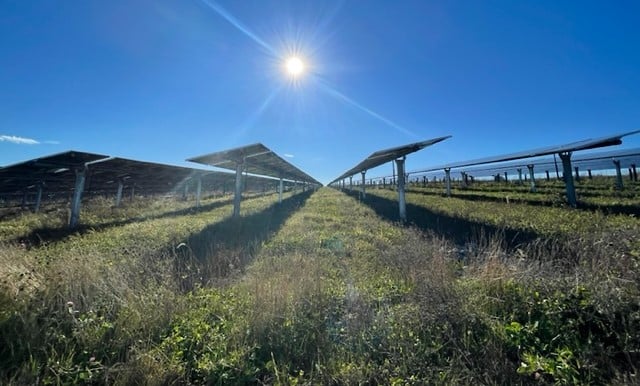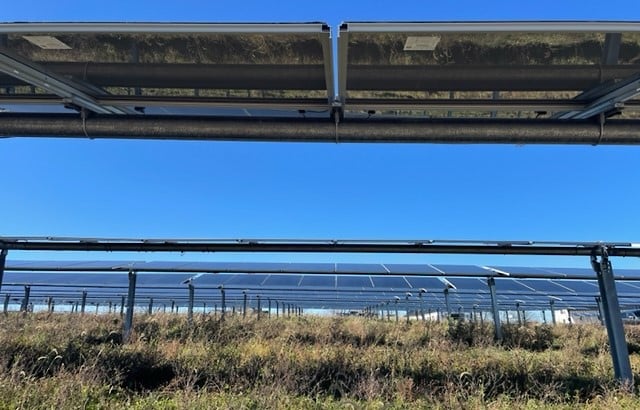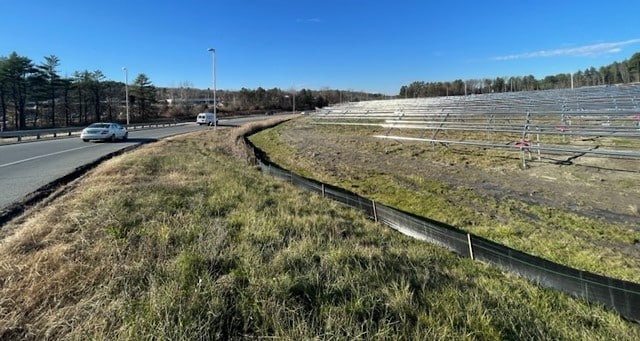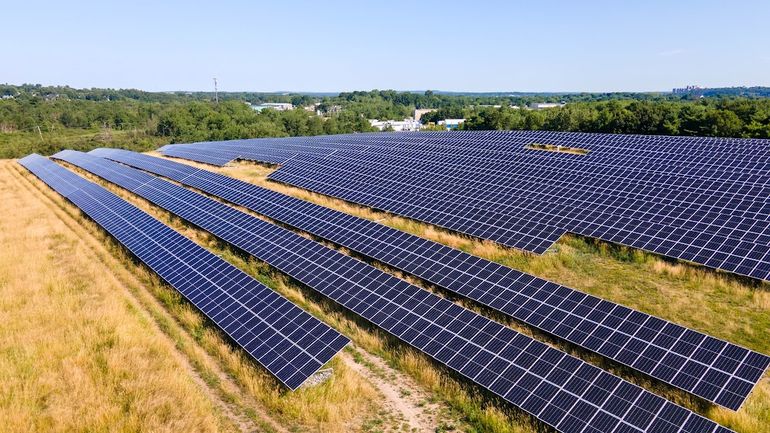
With climate change posing the number one threat to birds and other wildlife in Maine, and the need to reduce our dependence on fossil fuels as urgent as ever, Maine Audubon has cheered on the growth of local solar energy in recent years.
We also recognize the potential impacts to wildlife and habitat from solar development, including habitat loss and other disruptions. To help, Maine Audubon has produced a solar siting toolkit that includes guidance documents, draft ordinances, best management practices, vegetation guides, maps, and other tools to help ensure that the impacts of solar development are minimized to the greatest extent possible.
These three Maine projects serve as excellent examples of siting solar projects with wildlife and habitat in mind.
Monmouth Solar
Rick Dyer, a fourth-generation farmer in Monmouth, knew he needed to diversify if he wanted to keep his dairy farm in operation, and considered whether solar development on a portion of his land might provide stability. He worked with Longroad Energy to produce 4.95 megawatts of solar energy on about 36 acres of his 1,000 acre property.
Farming is difficult and unpredictable, and operates on thin margins. For some, solar development on sections of farmland or on parcels that aren’t being farmed can provide reliable income.
“It provides a buffer by which if all else were to end tomorrow,” Dyer told the Maine Monitor, “the economic value that comes in will pay the taxes on the entire property for the next 20 to 40 years and maybe beyond.”

From the beginning, the landowner and Longroad took a number of steps to limit the impacts of the project on his agricultural fields, minimize visual impacts, and promote the use of native plant species. The resulting project, now in operation, is a model for how solar can play a complementary role for farmers, providing a reliable and consistent source of income while agriculture continues as normal.
Longroad consulted with Maine Audubon on the use of pollinator-friendly native plants to serve as a buffer to screen the project from the road. Maine Audubon recommends maximizing the benefits of ground-mounted solar by planting plants that support native wildlife – and recently released our guide to Habitat Restoration and Native Planting for Maine Solar Development. Longroad planted Bayberry, Inkberry, American Hornbeam, and other native plants at the site on Maine Audubon’s advice.
Monmouth Solar represents a model for how farmers can use solar to supplement their incomes without giving up their livelihoods, and also how renewable energy can be developed with little impact to the surroundings, and a positive impact on local wildlife.
Augusta Cloverleaf Project
Maine Audubon’s solar siting toolkit also includes recommendations to prioritize the use of marginal or unused lands for projects, and there may be no more marginal land than a highway interchange. The Maine Department of Transportation (MDOT) is building a 3.2 megawatt project on land in the middle of an I-95 cloverleaf in Augusta, enough to power more than 850 homes.
Disturbed roadside lands are an ideal spot for solar development. The land can’t be used for housing or agriculture, and is too small and dangerous to be quality wildlife habitat. In fact, encouraging wildlife to use highway lands is dangerous both to wildlife and to drivers, and the Augusta interchange being developed was known locally as a hotspot for deer-car collisions. Furthermore, using highway lands may reduce the need for long transmission lines or new access roads due to the fact that they are often proximate to existing development.

The project will keep wildlife safe by keeping them away from the highway, and it will also help pollinators. MDOT and the developer, Cenergy, agreed to plant pollinator-friendly native species on the ground around the panels, which will also serve to make the area more visually pleasing as the plants grow in.
There are believed to be more than 50,000 acres of unused roadside land in the lower 48 states, enough to power 4.5 million homes. Other states, including Massachusetts, Maryland, Georgia, Florida, and Oregon, have already begun developing their roadsides, and if more projects came online we could avoid development on more valuable habitats while still benefiting from solar.
Maine Audubon has been vocal in our support for this innovative project. Our Advocacy Director Eliza Donoghue has penned an op-ed with Bruce Van Note, MDOT commissioner, and our Conservation Biologist Sarah Haggerty appears in a video (below) to share her perspective on why this location is such a good one for solar development.
Another ideal location for solar development is a capped landfill, which, like highway interchanges, cannot be used for other purposes. There are thousands of landfills in the country and, along with places like brownfields, parking lots, rooftops, idle or underutilized industrial or commercial sites, and sand and gravel pits, they can host solar panels without losing high-value wildlife habitat or agricultural land.
In 2022, the City of South Portland completed a massive 4.7 megawatt solar project on a city-owned capped landfill, enough to power 63 percent of the city’s municipal electric load and displace 4,100 metric tons of annual carbon emissions. The project is a collaboration between South Portland, Calibrant Energy, and ReVision Energy, and was completed in three stages beginning in 2017. Now complete, it is the largest landfill solar project in the state.

Other towns in Maine are catching on and are instituting their own landfill solar projects. Eliot, Windham, Cumberland, Winterport, and Portland are among the other municipalities reaping the benefits of solar, benefitting from clean, locally-produced renewable energy while protecting wildlife habitat.
We applaud these projects and others in Maine that are moving us in the right direction to meet our climate goals.
